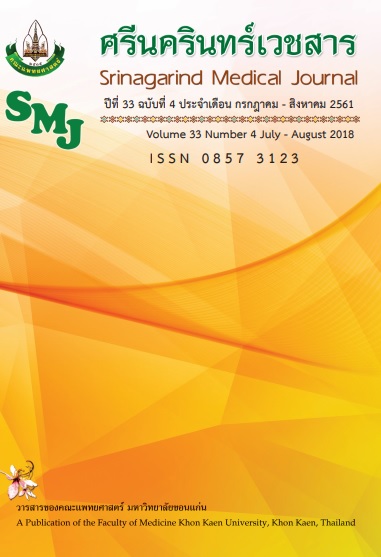The Optimal Cut-Off Score of the Dynamic Balance Test for Predict Risk of Falls in Community-Dwelling Older Adults
Keywords:
Elderly; Falls; balance control; community; Physical TherapyAbstract
Objective: This study aimed to explore optimal cut-off score of the Timed Up and Go test (TUGT) for implement to predict risk of falls in elders aged 60 – 74 and 75 year old or above.
Method: The volunteer subjects were 120 elders aged 60 years and above and divided into two groups; 60-74 and 75 years and above. All subjects were asked to subjective and objective examination and interview the history of falling previous 6 months. After that, they were asked to performed TUGT.
Results: In both groups, the falling subjects required significantly more time to complete the test than those in non-faller group (p = 0.001). The group of 60 – 74 years old, showed the optimal cut off score to predict risk of falls is 10.74 seconds (sensitivity = 90.00% and specificity = 81.82%). In addition, the group of 75 years old or above showed the optimal cut off score 14.58 seconds (sensitivity = 97.14% and specificity = 82.61%)
Conclusion: This study indicated that the group of 60-74 years old who had a time to complete TUGT of 10.74 seconds or more had a higher risk of falling. In the group of 75 years or older, it was found that if the TUGT time of 14.58 seconds or more indicated a risk of falling.
References
2. Hill K, Schwarz J, Flicker L. Carroll S. Falls among healthy community dwelling older women: A prospective study of frequency, circumstances, consequences and prediction accuracy. Aust N Z J Public Health 1999; 23: 41-8.
3. Tinetti ME, Speechley M. Ginter SF. Risk factors for falls among elderly persons living in the community. N Engl J Med 1988; 319: 1707-7.
4. Woollacott MH, Tang PF. Balance control during walking in the older adult: Research and its implications. Phys Ther 1997; 77: 646-60.
5. Csuka M, McCarty DJ. Simple method for measurement of lower extremity muscle strength. Am J Med 1985; 78: 77-81.
6. Poncumhak P, insorn T, Prasittimet N, Manota P. The Pilot Study on the Risk of Fall Prediction in Thai Elderly Using Five Times Sit-to- Stand Test. Srinagarind Med J 2014; 29: 237-42.
7. Verheyden G, Kampshoff CS, Burnett ME, Cashell J, Martinelli L, Nicholas A, et al. Psychometric properties of 3 functional mobility tests for people with Parkinson disease. Phys Ther 2014; 94: 230-9.
8. Montes J, Cheng B, Diamond B, Doorish C, Mitsumoto H, Gordon PH. The Timed Up and Go test: predicting falls in ALS. Amyotroph Lateral Scler 2007; 8: 292-5.
9. Lin MR, Hwang HF, Hu MH, Wu HD, Wang YW, Huang F. Psychometric comparisons of the timed up and go, one-leg stand, functional reach, and Tinetti balance measures in community-dwelling older people. J Am Geriatr Soc 2004; 52: 1343-8.
10. Viccaro LJ, Perera S, Studenski SA. Is Timed Up and Go Better Than Gait Speed in Predicting Health, Function, and Falls in Older Adults? J Am Geriatr Soc 2011; 59: 887-92.
11. Poncumhak P, Sittitan M, Thammachai A, Wongsaya E. The Development of the Three Times Stand and Walk Test for Predict Risk of Falls in Thai Community-Dwelling Elderly. Thai Journal of Physical Therapy 2016; 38: 48-58.
12. Podsiadlo D, Richardson S. The timed "Up & Go": a test of basic functional mobility for frail elderly persons. J Am Geriatr Soc 1991; 39: 142-8.
13. Berg KO, Maki BE, Williams JI, Holliday PJ, Wood-Dauphinee SL. Clinical and laboratory measures of postural balance in an elderly population. Arch Phys Med Rehabil 1992; 73: 1073-80.
14. Hatch J, Gill-Body KM, Portney LG. Determinants of balance confidence in community-dwelling elderly people. Phys Ther 2003; 83: 1072-9.
15. Bischoff HA, Stahelin HB, Monsch AU, Iversen MD, Weyh A, von Dechend M, et al. Identifying a cut-off point for normal mobility: a comparison of the timed 'up and go' test in community-dwelling and institutionalised elderly women. Age Ageing 2003; 32: 315-20.
16. Bohannon RW. Reference values for the timed up and go test: a descriptive meta-analysis. J Geriatr Phys Ther 2006; 29: 64-8.
17. Shimada H, Suzukawa M, Tiedemann A, Kobayashi K, Yoshida H, Suzuki T. Which neuromuscular or cognitive test is the optimal screening tool to predict falls in frail community-dwelling older people? Gerontology 2009; 55: 532-8.
18. Nordin E, Lindelof N, Rosendahl E, Jensen J, Lundin-Olsson L. Prognostic validity of the Timed Up-and-Go test, a modified Get-Up-and-Go test, staff's global judgement and fall history in evaluating fall risk in residential care facilities. Age Ageing 2008; 37: 442-8.
19. Thaweewannakij T, Amatachaya S, Peungsuwan P, Lugkana M. Balance, fall and quality of life in active and inactive elderly. J Med Tech Phy Ther 2010; 22: 271-9.
20. Ajchamon Thammachai, Nichapa Parasin, Eakarach Wongsaya, Seeharach. K. Relationship of Functional Mobility and Quality of Life with Executive Function in Older Adults. Srinagarind Med J 2017; 32: 435-43.
21. Chantanachai T, Pichaiyongwongdee S, Jalayondeja C. Fall prediction in thai elderly with timed up and go and tandem walk test: a cross-sectional study. J Med Assoc Thai 2014; 97 (Suppl 7): S21-5.
22. Buatois S, Perret-Guillaume C, Gueguen R, Miget P, Vancon G, Perrin P, et al. A simple clinical scale to stratify risk of recurrent falls in community-dwelling adults aged 65 years and older. Phys Ther 2010; 90: 550-60.
23. Horton K. Falls in older people: the place of telemonitoring in rehabilitation. J Rehabil Res Dev 2008; 45: 1183-94.




